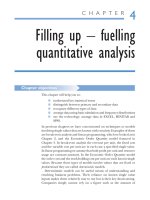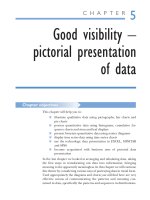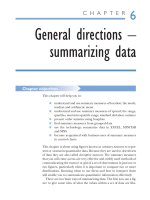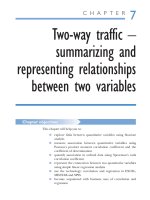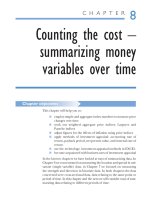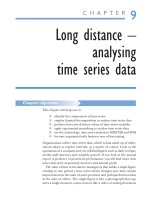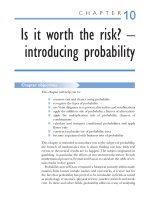Research methods for business 5th ch4
Bạn đang xem bản rút gọn của tài liệu. Xem và tải ngay bản đầy đủ của tài liệu tại đây (502.33 KB, 27 trang )
Slide 4.1
Chapter 4
Understanding research philosophies
and approaches
Saunders, Lewis and Thornhill, Research Methods for Business Students, 5th Edition, © Mark Saunders, Philip Lewis and Adrian Thornhill 2009
Slide 4.2
Saunders, Lewis and Thornhill, Research Methods for Business Students, 5th Edition, © Mark Saunders, Philip Lewis and Adrian Thornhill 2009
Slide 4.3
Underlying issues of data collection and
analysis
The research ‘onion’
Saunders et al, (2008)
Figure 4.1 The research ‘onion’
Saunders, Lewis and Thornhill, Research Methods for Business Students, 5th Edition, © Mark Saunders, Philip Lewis and Adrian Thornhill 2009
Slide 4.4
Saunders, Lewis and Thornhill, Research Methods for Business Students, 5th Edition, © Mark Saunders, Philip Lewis and Adrian Thornhill 2009
Slide 4.5
Understanding your research philosophy
(1)
‘Research philosophy is an over-arching
term relating to the development of
knowledge and the nature of that
knowledge’
Adapted from Saunders et al, (2009)
Saunders, Lewis and Thornhill, Research Methods for Business Students, 5th Edition, © Mark Saunders, Philip Lewis and Adrian Thornhill 2009
Slide 4.6
Understanding your research philosophy
(2)
Thinking about research philosophy
• Ontology
• Epistemology
• Pragmatism
Saunders, Lewis and Thornhill, Research Methods for Business Students, 5th Edition, © Mark Saunders, Philip Lewis and Adrian Thornhill 2009
Slide 4.7
Saunders, Lewis and Thornhill, Research Methods for Business Students, 5th Edition, © Mark Saunders, Philip Lewis and Adrian Thornhill 2009
Slide 4.8
Saunders, Lewis and Thornhill, Research Methods for Business Students, 5th Edition, © Mark Saunders, Philip Lewis and Adrian Thornhill 2009
Slide 4.9
Saunders, Lewis and Thornhill, Research Methods for Business Students, 5th Edition, © Mark Saunders, Philip Lewis and Adrian Thornhill 2009
Slide 4.10
Saunders, Lewis and Thornhill, Research Methods for Business Students, 5th Edition, © Mark Saunders, Philip Lewis and Adrian Thornhill 2009
Slide 4.11
Understanding your research philosophy
(3)
Aspects of ontology
• Objectivism
• Subjectivism
Saunders, Lewis and Thornhill, Research Methods for Business Students, 5th Edition, © Mark Saunders, Philip Lewis and Adrian Thornhill 2009
Slide 4.12
Understanding your research philosophy
(4)
Aspects of philosophy
• Positivism - the stance of the natural scientist
• Realism -
direct and critical realism
• Interpretivism – researchers as ‘social actors’
• Axiology – studies judgements about value
Saunders, Lewis and Thornhill, Research Methods for Business Students, 5th Edition, © Mark Saunders, Philip Lewis and Adrian Thornhill 2009
Slide 4.13
Saunders, Lewis and Thornhill, Research Methods for Business Students, 5th Edition, © Mark Saunders, Philip Lewis and Adrian Thornhill 2009
Slide 4.14
Saunders, Lewis and Thornhill, Research Methods for Business Students, 5th Edition, © Mark Saunders, Philip Lewis and Adrian Thornhill 2009
Slide 4.15
Saunders, Lewis and Thornhill, Research Methods for Business Students, 5th Edition, © Mark Saunders, Philip Lewis and Adrian Thornhill 2009
Slide 4.16
Research paradigms
Definition
‘A way of examining social phenomenon
from which particular understandings of
these phenomena can be gained and
explanations attempted’
Saunders et al. (2009)
Saunders, Lewis and Thornhill, Research Methods for Business Students, 5th Edition, © Mark Saunders, Philip Lewis and Adrian Thornhill 2009
Slide 4.17
Research Approaches (1)
Deduction
5 sequential stages of testing theory
•
•
•
•
•
Deducing a hypothesis
Expressing the hypothesis operationally
Testing the operational hypothesis
Examining the specific outcome of the enquiry
Modifying the theory (if necessary)
Adapted from Robson (2002)
Saunders, Lewis and Thornhill, Research Methods for Business Students, 5th Edition, © Mark Saunders, Philip Lewis and Adrian Thornhill 2009
Slide 4.18
Research Approaches (2)
Characteristics of Deduction
• Explaining causal relationships between variables
• Establishing controls for testing hypotheses
• Independence of the researcher
• Concepts operationalised for quantative
measurement
• Generalisation
Saunders, Lewis and Thornhill, Research Methods for Business Students, 5th Edition, © Mark Saunders, Philip Lewis and Adrian Thornhill 2009
Slide 4.19
Research Approaches (3)
Induction
Building theory by –
• Understanding the way human build their
world
• Permitting alternative explanations of what’s
going on
• Being concerned with the context of events
• Using more qualitative data
• Using a variety of data collection methods
Saunders, Lewis and Thornhill, Research Methods for Business Students, 5th Edition, © Mark Saunders, Philip Lewis and Adrian Thornhill 2009
Slide 4.20
Choosing your research approach
The right choice of approach helps you to
• Make a more informed decision about the
research design
• Think about which strategies will work for your
research topic
• Adapt your design to cater for any constraints
Adapted from Easterby-Smith et al. (2008)
Saunders, Lewis and Thornhill, Research Methods for Business Students, 5th Edition, © Mark Saunders, Philip Lewis and Adrian Thornhill 2009
Slide 4.21
Combining research approaches
Things worth considering
• The nature of the research topic
• The time available
• The extent of risk
• The research audience – managers and markers
Saunders, Lewis and Thornhill, Research Methods for Business Students, 5th Edition, © Mark Saunders, Philip Lewis and Adrian Thornhill 2009
Slide 4.22
Deductive and Inductive research
Major differences between these approaches
Saunders et al, (2009)
Table 4.2 Major differences between deductive and inductive approaches to
research
Saunders, Lewis and Thornhill, Research Methods for Business Students, 5th Edition, © Mark Saunders, Philip Lewis and Adrian Thornhill 2009
Slide 4.23
Summary: Chapter 4
Research philosophy
• relates to the development of knowledge
and
the nature of that knowledge
• contains important assumptions about the
way in which you view the world
Saunders, Lewis and Thornhill, Research Methods for Business Students, 5th Edition, © Mark Saunders, Philip Lewis and Adrian Thornhill 2009
Slide 4.24
Summary: Chapter 4
Three major ways of thinking about research
philosophy
• Epistemology
• Ontology – objectivism and subjectivism
• Axiology
Saunders, Lewis and Thornhill, Research Methods for Business Students, 5th Edition, © Mark Saunders, Philip Lewis and Adrian Thornhill 2009
Slide 4.25
Ontology is the theory of objects and their ties. It provides
criteria for distinguishing different types of objects
(concrete and abstract, existent and nonexistent, real and
ideal, independent and dependent) and their ties (relations,
dependencies and predication).
Saunders, Lewis and Thornhill, Research Methods for Business Students, 5th Edition, © Mark Saunders, Philip Lewis and Adrian Thornhill 2009



